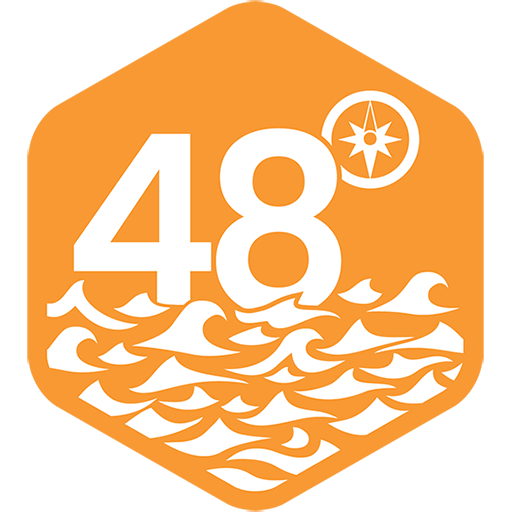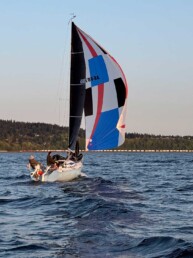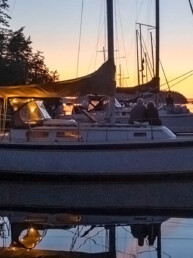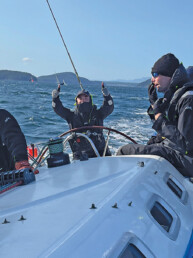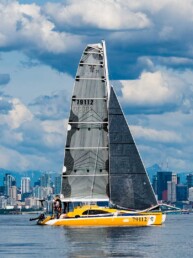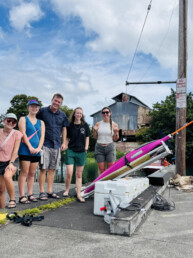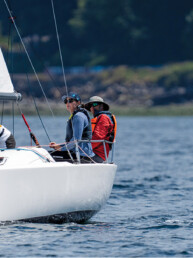This article was originally published in the October 2021 issue of 48° North.
After I retired from teaching, my wife and I moved to Tacoma to be closer to our son and escape the wildfires of Northern California. As we spent occasional afternoons visiting our son and strolling around the neighborhoods of Tacoma, we were amazed to discover that beautiful views of Puget Sound appeared around nearly every corner of our journey. And when our path brought us down to the shoreline, it seemed like we couldn’t walk more than a mile or two without passing a marina or dock.
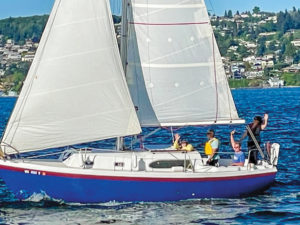 The message seemed clear. What better way to enjoy the beauty of the Pacific Northwest, spend some time relaxing, a lot of time fixing, and a little time on the water than to own a sailboat? My wife has always loved either being in the water, on the water, or by the water, and has even gone so far as to think of herself as a land mermaid! So, despite our complete lack of experience, we jumped into the search for a boat and moorage.
The message seemed clear. What better way to enjoy the beauty of the Pacific Northwest, spend some time relaxing, a lot of time fixing, and a little time on the water than to own a sailboat? My wife has always loved either being in the water, on the water, or by the water, and has even gone so far as to think of herself as a land mermaid! So, despite our complete lack of experience, we jumped into the search for a boat and moorage.
One of our regular walking routes took us along the edge of a beautiful marina, located on a point with immediate waterway access to locations in the south Puget Sound. So, even though we had no idea what boat would be right for us, we started looking at moorage fees and club dues. The primary agent of that local yacht club put us in touch with Matt, an amiable and helpful dock manager. Matt is the kind of guy who instantly makes you feel at ease, as though you’ve known him your whole life. My wife and I spoke with or texted him nearly every day for a couple of weeks before actually meeting him face to face; or, because of Covid, “mask to mask”.
We met down on A Dock, our soon-to-be home of our yet-to-be purchased sailboat, where our conversations moved from the benefits of joining the yacht club (specifically mooring on A dock) and steered their way to the real issue at hand: what were we looking for by acquiring a boat? Even though Matt pressed us on our budget, our experience, and our intention in having the boat — it seemed to us that our search was extending beyond the concrete and numerical specifications of the ideal vessel for us. In Matt’s view, a boat has to complement the owner. His philosophy bordered on that of the wand shop owner in the Harry Potter series. “The wand chooses the wizard”, Ollivander told Harry. In our story, it would appear that the boat would choose the captain.
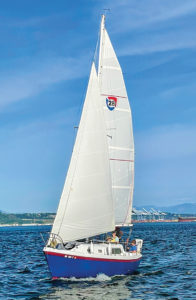 Matt enlisted the help of another club member, William, who was the proud owner of a beautiful Miller 44. In selecting the right vessel, William emphasized the relationship that a boat owner has with their boat. A romantic at heart, William felt that if you didn’t fall in love with the boat at first sight, it probably wasn’t right for you. Furthermore, since we were essentially first-time sailors, safety should be a primary consideration for our purchase. He was adamant that we did not purchase a boat with an outboard motor, as rough seas could prevent the prop from always remaining submerged and powering the boat to a safe harbor. On the other hand, we felt that an outboard motor would be easier to service or replace than an inboard. Matt was a bit more practical on the question of inboard or outboard, and was not as concerned about its efficacy in rough waters. Matt pointed to some of his father’s wisdom, which reminded us that sailors have options in heavy weather — and the best of them may well be to wait for calmer conditions before heading out.
Matt enlisted the help of another club member, William, who was the proud owner of a beautiful Miller 44. In selecting the right vessel, William emphasized the relationship that a boat owner has with their boat. A romantic at heart, William felt that if you didn’t fall in love with the boat at first sight, it probably wasn’t right for you. Furthermore, since we were essentially first-time sailors, safety should be a primary consideration for our purchase. He was adamant that we did not purchase a boat with an outboard motor, as rough seas could prevent the prop from always remaining submerged and powering the boat to a safe harbor. On the other hand, we felt that an outboard motor would be easier to service or replace than an inboard. Matt was a bit more practical on the question of inboard or outboard, and was not as concerned about its efficacy in rough waters. Matt pointed to some of his father’s wisdom, which reminded us that sailors have options in heavy weather — and the best of them may well be to wait for calmer conditions before heading out.
With all of this advice swirling round in our heads, my wife and I began our search for our perfect boat. We must have looked at a dozen boats in person, and about a hundred more on Craigslist or SailboatListings.com. Nearly every morning our cell phones would be bursting with the latest finds by Matt and William, causing both excitement and urgency. “Is this the one?” “Should we go see it right now?” “What if a better boat comes along?” Our search took us up and down the coastal roadways of the Salish Sea, from Olympia to Blaine, and Everett to Port Ludlow. Our first viewing was an Ericson 27, which had the potential to be the one, had it not been on a trailer in the owner’s side yard. Ascending an 8-foot ladder to reach the cockpit made us feel dwarfed by the massive proportions of the boat. To make matters worse, the mast lay across the deck, requiring us to step it once we trailered it to the marina. Both of these tasks seemed overwhelming and/or expensive to novice sailors like ourselves.
About this time, William and Matt tried to focus our search, asking what sort of things we wanted to do on the boat. My wife jokingly responded, “to make sandwiches like Grace Kelly’s character in High Society, of course. Remember the True Love? My, she was yar.” After a good laugh, they agreed that anything smaller than a 27-foot Catalina would probably not fit the bill.
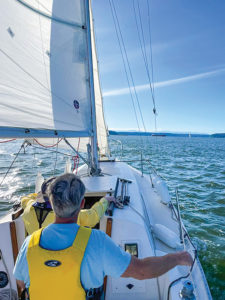 Although upon telling them that we turned our Toyota Sienna car into a mini RV for car camping, they wondered if we might want to look at a 26-foot Thunderbird, the Northwest-designed plywood-hulled boat with no galley or head, which they referred to as a “boat camper”.
Although upon telling them that we turned our Toyota Sienna car into a mini RV for car camping, they wondered if we might want to look at a 26-foot Thunderbird, the Northwest-designed plywood-hulled boat with no galley or head, which they referred to as a “boat camper”.
Keeping an open mind, we said, “Well, maybe we’ll only be out on the water for about two hours. No toilet needed in that period of time, and really no need for a stove if we’re just making sandwiches.” After looking at a Thunderbird in person and getting a back spasm from hunching over to inspect the below-deck “cabin”, we decided that proper galley with a real table was a must have.
Then along came a Herreshoff Eagle. “But what about the kitchen and toilet?” we lamented. William pleaded with us: “Just go look at this boat. You’ll fall in love with it.” Arriving at the boat owner’s home, we saw the Eagle in the driveway on a trailer. “Looks like the Eagle has landed,” we quipped. It was beautiful. It looked like Captain Jack Sparrow himself owned this boat at one time. I was disappointed to discover that it didn’t have cannon bays below deck, although they could have been hiding around the beams and posts that forced me once again to hunch, squat and bump my head. “No,” we told William, “no boat camping for us. No matter how beautiful the boat is.”
William took another tack with us, so to speak. If a gorgeous boat doesn’t speak to you, then perhaps a solid, dependable “bullet-proof” one might. Enter the Miller 29 (remember, William owns a Miller 44), which may have been a contender had it not been for three things: its electrical system ran on a funky solar powered battery configuration; it had a slow oil leak in the engine, which could have cost thousands to repair; and it was located about 200 miles from our home. Before we officially said no to the Miller, Matt found us a neglected Newport 30 at a nearby marina, which he referred to as “the green boat”, not just because of its viridian boot stripe, but also because of the moss adorning the deck-to-hull joints. The owner was just getting too old to sail or, of course, to care for the vessel. He was a lovely gentleman who arranged a viewing for us in a week or so. In the meantime, we were off to see a Columbia 22, right back to the “no galley, no head” cabin; on the bright side, it was named the Innes Reagh, adorned with green-painted Celtic knots along the hull, and owned by a man from Ireland with a lively brogue. He took us for a quick sail around the harbor, and even though we would have loved to own a boat with ties to my ancestral lands, we had to let it go.
With the sailing season quickly approaching and our moorage fees coming due, we were beginning to get a little desperate. So we chose to look at a dilapidated San Juan 28, whose low price was not quite low enough to even haggle. When the owner begged, “Make me an offer, any offer,” William replied, “How about giving us $3,000 to haul it away?”
On our way home from the San Juan fiasco, Matt called our cell. “A Columbia 28 just came on the market. It was built in 1973, but it’s an amazing price and it looks really good.” My wife called the number from the car. “Hold that boat! We’re on our way! Don’t let anyone else see it before us.” The owner, in her late 20s, obliged.
We went by the bank on our way to the marina, ready to make an offer. We arrived at the dock to find a cute little navy blue boat with a vinyl decal of a mermaid on the foredeck of the cabin. And the name of the boat: Ariel. Giving it a quick once over on the deck and then heading below to the cabin, we found what felt to us like a big floating treehouse. It was perfect! Love at first sight — an outboard motor in a well, a place to make sandwiches, and a new mainsail and genoa to fulfill the boat’s destiny of wind-powered travel. My land mermaid wife was about to become a true woman of the sea. Sandwiches, anyone?
